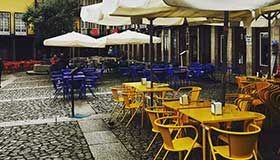It was my great privilege to host 26 WAA travelers as we cruised from Memphis to New Orleans on the world’s largest riverboat, The American Queen.
Any description of this trip has to start with the boat. Built in 1994, The American Queen is the largest steamboat ever built (90 feet wide and 418 feet long), and is the only steam-powered boat of its kind. Its two steam engines were salvaged from a dredging craft and completely rebuilt before being put back to work powering The American Queen's paddlewheel. The rest of the boat is painstakingly appointed with a combination of authentic and reproduction period furnishings, fixtures and artwork.
Thursday, May 15—Memphis
Upon arrival, we gathered at the famed and fabulous Peabody Hotel for a two-night stay. "Memphis in May," an annual rib-cooking competition, meant the downtown area was crowded and jumpin’, with live music emanating from what seemed like every third door on both sides of Beale Street.
Friday, May 16
After a lunch of deep-fried everything at a famous area eatery, the Catfish Hotel on the Tennessee River, we made a stop at the Corinth, Miss. Interpretive Center before entering Shiloh National Military Park. Beautiful and somber, Shiloh is known for the battle that produced more casualties in two days than in all other previous American wars combined. That distinction shocked the nation with the painful realization that the war would not be over in a few weeks, as many on both sides had wrongly believed.
Saturday, May 17
With a little urging from others, I took the opportunity to sign up for a trip to Graceland, which combined a brief historical tour of Memphis by bus before arriving at the estate that Elvis built. My wish to go to Graceland was mainly so I could call my wife while on the bus and sing to her the refrain from the Paul Simon song of the same name. Our bus tour guide was an octogenarian born and raised in Memphis. Her detailed knowledge of historical figures, places and events made for a better-than-expected bus ride. It was quite a jolt to turn a corner and see, in person, the hotel where Martin Luther King, Jr. was killed, his room balcony now marked by a solitary white wreath and guarded at the parking lot entrance by a large security officer whose job is to keep people from stopping there on the street, including in tour buses. Our tour guide’s memorable quote: "When James Earl Ray took that shot, our entire city exploded."
Graceland, while it doesn’t seem to be in the same cultural category as the antebellum South, is very important to the city of Memphis and is an undeniable part of our country’s more modern, Southern culture.
Saturday’s cloudy, rainy weather remained as we boarded The American Queen at 3 p.m. Upon boarding, we were taken immediately past the separate men’s and ladies’ parlors, through the Mark Twain Gallery (with its Tiffany lamp collection and extraordinary period furnishings) and to the main lobby, all on the second deck level. Our cabins were surprisingly roomy and very comfortable, with dedicated porters attending to the rooms’ order and cleanliness twice daily. Each day, the AQ staff provided a four-page newsletter describing the day’s port of call, weather forecast and a full schedule of meals, lectures excursions and other onboard events — a very nice touch and extremely useful as a day planner. This night included our first live musical performance in the Grand Saloon, an excellent band that expertly revived classic tunes by such legendary Sun Records artists as Johnny Cash, Elvis Presley and Jerry Lee Lewis.
Sunday, May 18
Rain also marked the first full day of cruising the river on Sunday, but there was plenty to do on the boat. The boat’s Riverlorian, Travis, explained river navigation terms and how to identify cargo carried by the many barges we encountered: our first two GoNext guest lecturers explained life on slave plantations and the story-telling importance of writers and artists in the antebellum South. We also got our first look (and listen) at the resident American Queen Ensemble, four multi-talented entertainers backed by an excellent house band.
Monday, May 19
Monday morning offered up our first dose of Southern sun (and heat) in Vicksburg, Miss., where we had docked during the night. A mural-covered, concrete wall fronting the river protects the city, most of which is perched on the bluffs above. Our premium excursion this day was a bus tour of Vicksburg National Military Park, the site of the 47-day siege that, along with the battle at Gettysburg, resulted in the surrender of the Confederate army.
I was surprised to learn that 5,000 Wisconsin soldiers fought at Vicksburg, and our state erected a wonderful monument to the effort, topped by a bronze statue of the famous Screaming Eagle, Old Abe. This iconic bird has been the inspiration for many, including the U.S. Army’s famous 101st Airborne Division, which traces its roots to Milwaukee in 1921.
Vicksburg’s are the most accurately marked of all Civil War battlefields, owing to a 1906 reunion of 8,000 soldiers from both sides. Though elderly and in declining health, their detailed recall of encampments and strategic battles resulted in field markers that greatly enhance the history and experience for future generations of visitors and historians.
Tuesday, May 20
Named for the tribe that inhabited the area since the eighth century, Natchez, Miss. grew prosperous from the cotton trade, claiming to be the richest city in the U.S. in 1860. Wealthy plantation owners built mansions here, and they were spared during the Civil War when the town surrendered to Union forces. Many of these mansions remain in restored splendor, some of them perched high on the bluffs, with panoramic views of the river. One of the most notable and magnificent is Stanton Hall. Built before the Civil War by cotton broker William Stanton, it occupies an entire city block.
Upon returning to the boat, we enjoyed a guest lecture by the genteel William Ferris, a distinguished professor from the University of North Carolina who combined pictures, words and music in a thoroughly entertaining talk titled "Give My Poor Heart Ease: Voices of the Mississippi Blues."
Wednesday, May 21
Today’s shore landing was called Port of St. Francisville, the oldest town in the Florida Parishes of Louisiana. A short ride from shore took me into this small town (pop. 1,765), filled with beautiful antebellum homes and the pacing of a bygone era, when a strong sense of community was a town’s greatest asset.
The GoNext guest lecturer this afternoon was University of Virginia professor Elizabeth Varon, who shared with us the many roles of women during the Civil War, from both the North and the South. Medical care and benevolence were prime functions, but many women were also political activists who carried on the fight toward women’s suffrage after the war.
Thursday, May 22
In 1699, French explorers noted a red cypress tree, stripped of its bark, that marked the boundary between Houma and Bayou Goula tribal hunting grounds. They called the tree "le baton rouge," or red stick. Incorporated in 1817, Baton Rouge became Louisiana’s state capital in 1849. It's strategic location on the river was the cause of several Civil War battles, beginning with occupation by Union forces in 1862. Since the beginning of the twentieth century, Baton Rouge has benefited from industrial development and later experienced an economic boom with the growth of the petrochemical industry that continues to this day.
Baton Rouge was also home to Huey Long, who served as both governor and senator for his beloved home state. As governor, he built the tallest state capitol in the country, leaving behind the Old State Capitol, once called "the ugliest thing on the Mississippi" by one Mark Twain. The Old Capitol Building still stands in all its gothic glory and is one of the city’s top tourist attractions, with a stained-glass rotunda and gilded spiral staircase as the focal points of the interior.
On a guided eco-tour of private swamp land just north of New Orleans, towering cypress trees framed a pristine waterway filled with birds, (invasive) jumping fish and alligators that responded to the familiar boat captain’s raspy, Cajun-accented voice. Most of the gators responded to treats of marshmallows, but the captain called out one in particular that likes only chicken. The "eco" part of the tour was a very personal narrative about our guide’s lifetime experience growing up on the swamp. Proudly uneducated by books though he is, I found his account of the swamp’s history, characteristics and modern challenges very interesting.
Friday, May 23
Thirty-five miles south of Baton Rouge lies the Nottoway Plantation House, built from self-produced materials by the Randolph family in 1859 and separated now from the river’s edge by a massive, concrete levy. This Greek Revival-inspired compound was designed by Henry Howard, considered one of New Orleans’s greatest architects of the time. Our boat docked at the levy long enough for tours of the plantation’s grounds, which now include guest cottages and other amenities for the many weddings held on its picturesque grounds.
After a guided tour of the American Queen’s pilot house that afternoon, I joined most of the tour’s passengers to mingle with the boat’s captain, crew and staffers for a farewell celebration in the Grand Saloon, during which he presented certificates to all of us who provided our organization’s flag to fly aboard the boat during the week. Captain Brent Willits — an Iowa native and Hawkeye fan — is an expert ambassador of both his boat and his profession. He was also a very popular guest at our WAA travelers’ party on the first day of the cruise.







